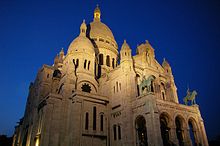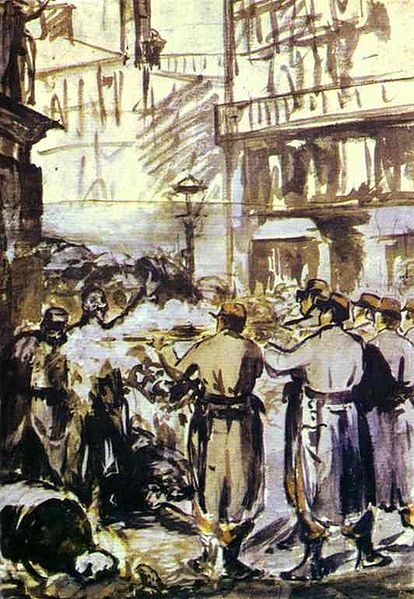Dawn of the Belle Epoque: The Paris of Monet, Zola, Bernhardt, Eiffel, Debussy, Clemenceau, and Their Friends

You know when you've convinced yourself you've done something only to turn around and realize it was your brain playing a trick on you? Apparently 3-4 reviews completely fell through the cracks; this was one and that's horrible because this book was quite an experience for me.
I'll confess, French history is not really my area. My focus has tended more towards UK history or American History Revolution - Civil War; two exceptions have been the first revolution (thanks to the Scarlet Pimpernel) and WWII courtesy of documentaries. So this was new territory for me and I'm glad I started with this book.
First and foremost, this is one of the best written history non-fiction books I've read in years. Mary McAuliffe is able to combine vast amounts of information with easy to read text that reminds me slightly more of fiction rather then non-fiction. This makes it easy to get through a chapter at a time, though I found myself have to pause several times  during reading in order to take in the information load coming at me. Also, as each chapter covers at most a year and usually only part of one, the knowledge comes at you in manageable chunks that are dispersed over multiple individuals. Usually a chapter checked in on between five to eight people while also connecting the larger events that carried over from previous chapters. Major events such as The Panama Scandal, the Sacré-Cœur, and the Dreyfus Affair could pop up at any moment over innumerable chapters.
during reading in order to take in the information load coming at me. Also, as each chapter covers at most a year and usually only part of one, the knowledge comes at you in manageable chunks that are dispersed over multiple individuals. Usually a chapter checked in on between five to eight people while also connecting the larger events that carried over from previous chapters. Major events such as The Panama Scandal, the Sacré-Cœur, and the Dreyfus Affair could pop up at any moment over innumerable chapters.
Dawn covers the years of the Belle Epoque from its inception (1871) to the turn of the century. The book started out with a huge event that dominated, for good or ill, the rest  of the century: France's defeat by Germany during the Franco-Prussian War and the uprising of the Paris poor as the Commune. I was shocked I knew nothing of this, particularly as more people died during it then the Reign of Terror! In one form or another, France attempted to recover from these two events for most of the book. Germany stopped France with a huge war debt - five billion Francs - which was a crazy sum at the time. Amazingly, they raised the money for part of the debt, two billion, within a month of the Commune defeat; actually in one day when the people pulled together over the loan the government floated and paid it off. These reparations and the humiliating experience of seeing German soldiers parade through Paris streets in triumph - another punishment demanded by the treaty - gave me a new understanding of the Treaty of Versailles after WWI and its harsh punishments towards the Germans.
of the century: France's defeat by Germany during the Franco-Prussian War and the uprising of the Paris poor as the Commune. I was shocked I knew nothing of this, particularly as more people died during it then the Reign of Terror! In one form or another, France attempted to recover from these two events for most of the book. Germany stopped France with a huge war debt - five billion Francs - which was a crazy sum at the time. Amazingly, they raised the money for part of the debt, two billion, within a month of the Commune defeat; actually in one day when the people pulled together over the loan the government floated and paid it off. These reparations and the humiliating experience of seeing German soldiers parade through Paris streets in triumph - another punishment demanded by the treaty - gave me a new understanding of the Treaty of Versailles after WWI and its harsh punishments towards the Germans.
And the new information just kept coming. I never knew how...unstable the French  government was during so much of the time after the first French Revolution. The Belle Epoque occurred during the Third Republic and at least once or twice it was unclear how long it would continue. World's Fairs in 1878, 1889, and 1900, the issues surrounding the Sacré-Cœur, and Eiffel's building efforts and the fallout over the Panama Canal kept the society of the Belle Epoque often balanced on a knife's edge. Perhaps that's partially why places such as the Moulin Rouge and Le Chat Noir, as well as other excesses of the age were so overt and well known. Gaity seems to mix with fear a great deal during this time. It was a time of extremes; one that constantly surprised me. I've already read a true-crime book, Little Demon, about a murder case that occurred while the Exposition Universelle 1889 was going on that contained hypnotism, media, and early forensic science.
government was during so much of the time after the first French Revolution. The Belle Epoque occurred during the Third Republic and at least once or twice it was unclear how long it would continue. World's Fairs in 1878, 1889, and 1900, the issues surrounding the Sacré-Cœur, and Eiffel's building efforts and the fallout over the Panama Canal kept the society of the Belle Epoque often balanced on a knife's edge. Perhaps that's partially why places such as the Moulin Rouge and Le Chat Noir, as well as other excesses of the age were so overt and well known. Gaity seems to mix with fear a great deal during this time. It was a time of extremes; one that constantly surprised me. I've already read a true-crime book, Little Demon, about a murder case that occurred while the Exposition Universelle 1889 was going on that contained hypnotism, media, and early forensic science.
But what truly made this book shine were the lives of the people it followed during this time. People's lives like
 General Georges Ernest Boulanger,
General Georges Ernest Boulanger,
 Émile Édouard Charles Antoine Zola,
Émile Édouard Charles Antoine Zola,
and (my favorite)Berthe Morisot
are followed throughout the book and you see the years, events and era measured through events in their lives. Many of them played huge parts during the events covered in the book, such as Clemenceau and Zola, but each left their mark on the Belle Epoque. I found the saga of the Impressionists the most interesting parts of the book; discovering the sordid details of the artists' lives is never my favorite but I have never understood that style of artwork before and have now come to appreciate it more then I could have ever dreamed. I found Morisot's life particularly interesting and couldn't wait to find out what each year brought her.

I don't think a book has taught me more since...sophomore year of college. I greatly enjoyed it and can't wait to pick up the next book, Twilight of the Belle Epoque. If you don't know much about this time period or are going to read a book set during these years, I highly recommend picking up this book. If you simply like well written history books, this is definitely a good choice.
----------------------------------------
All of the links above lead to Wikipedia. I have them there for two purposes: to provide me easy jolts to my memory when I come back to this review and to wet your appetite to learn more. For in depth and well explained information, I highly recommend this book...and its extensive bibliography. I know I have a whole page filled of books to look for after digging into the footnotes.


 Sarah Bernhardt
Sarah Bernhardt Georges Clemenceau
Georges Clemenceau 13
13
 7
7












